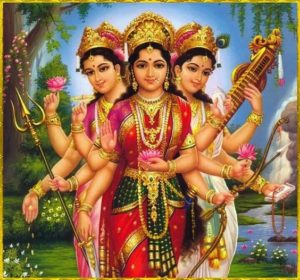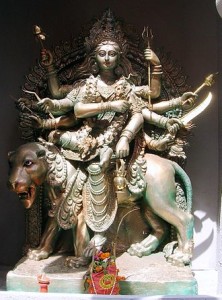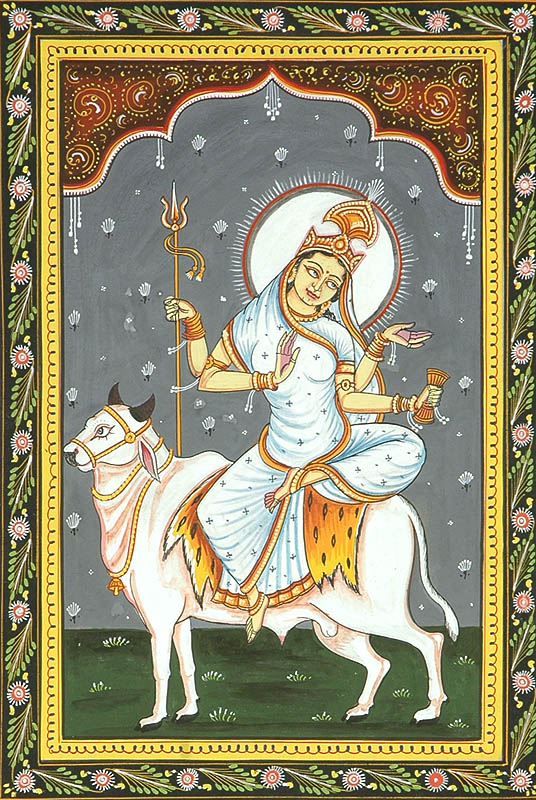Maha Navaratri 2019 is upon us! In this important Hindu holiday, we celebrate the Goddess through “the great nine nights” (nav = nine, ratri = night). This festival will run from September 29th through October 8th, the first ten days of this new lunar cycle. Goddess, Devi, Shakti, Durga, Divine Mother—the many names and forms all represent the dynamic and fluid feminine power that enlivens all of existence.
She is the creatrix, the warrioress, the nurturer, the purifyer, the protector. While she’s in the innocent and fertile maiden so is she the wise and learned crone. Both the nurturing mother, and the one who gives “tough love.” The impassioned lover, the devoted bhakta, the disciplined yogini. We see Goddess appear through us in innumerable manifestations. Through her many forms she teaches us and offers us countless blessings–love, compassion, courage, learning, discipline, surrender, success, enlightenment, and bliss. This festival is a time for celebrating the supreme feminine power in all her glory, and the many blessings she bestows upon us.
As with most Hindu celebrations, this festival correlates with the lunar calendar, and thus begins on the first day of the waxing Moon after the New Moon of September 28th. The celebration is through the “nine nights” of September 29th through October 7th, and into the tenth morning known as Vijayadashami, “the day of victory.” Worship during Navaratri is most generally dedicated to Goddess in the form of Durga, the demon-slayer, but there is much nuance and variation to practice and forms of celebration throughout India. Above all, Navaratri is a community celebration of the Divine Mother, and the love, abundance and protection she gives.
There are many Navaratri celebrations throughout the year, but the fall-time Navaratri is the most widely celebrated, and is thus called Maha Navaratri – “the great nine nights”. It correlates with the time of the harvest, a time to give thanks for the abundance of the year’s work. Grains and crops are often offered to Devi as part of the celebrations. Ritualistic worship (puja) typically occurs in homes and temples throughout the nine nights and into the tenth morning of celebration.
The Many Forms of Goddess
Durga-Lakshmi-Sarasvati
In Kerala and other places in India, the first three nights of worship are dedicated to Durga (the invincible), the next three to Lakshmi (Goddess of prosperity), and the final three to Sarasvati (Goddess of learning). Durga, also celebrated as her incarnation of Kali, helps us to destroy and remove the negative tendencies in our minds and hearts, freeing us from the obstructions to our spiritual and material pursuits. Lakshmi helps us to cultivate positive qualities like compassion and devotion, and leads us towards both spiritual and material prosperity. Sarasvati assists us in attaining knowledge and wisdom, through the illumination of our consciousness. She aids in awakening sattva, the quality of purity, and the flow of prana, the vital breath. After removing inner and outer obstacles and cultivating prosperity through virtuous qualities, our devotion, service, and practice help us to attain a state of peace, bliss, and oneness.
Sarasvati-Lakshmi-Kali/Durga
In the Kali Kula (Kali school of worship) in northeastern India, Sarasvati is worshiped on the first three nights, followed by Lakshmi on the next and then Kali/Durga on the last three. Sarasvati, Lakshmi, and Kali/Durga (Kali emerged from Durga) are also known as the consorts of Brahma, Vishnu, and Shiva. The Goddesses, therefore, provide the shakti to the cosmic processes of creation, preservation, and death (transformation), similar to their male counterparts. Consequently, worship in this manner is dedicated to the cycles of life and Mother nature, through birth, then sustenance, then death. Death is not a complete stop, but allows for the regeneration of energy into a new cycle once again.
9 Forms of Durga
Throughout India, the nine nights of Navaratri are often dedicated to 9 different incarnations of Durga, allowing the worship of many different aspects of Shakti in a gradual evolution. You can read the stories and significance of these 9 goddesses here, or a more a brief introduction, here:
 1. Shailputri (September 29th)
1. Shailputri (September 29th)
“Daughter of the mountain”; creative energy, muladhara (root chakra), awakening; Awaken your connection with Goddess today or initiate a new venture, calling on Shailputri for new beginnings.
2. Brahmacharini (September 30th)
The ascetic; tapas, discipline, devotion, strength, wisdom, creative abundance; Good day for fasting and meditation, connection with svadhistana (sacral chakra).
3. Chandraghanta (October 1st)
Warrioress; protection, courage, grace, manipura (solar plexus); Destroy your internal obstacles by offering them to Chandraghanta.
4. Kushmanda (October 2nd)
Creatrix of the “cosmic egg”; strength, health, happiness, success, relationships; Connect with the vital Sun energy and the anahata (heart chakra) today.
5. Skandamata (October 3rd)
“Mother of Skanda/Kartikeya”; motherly love, nourishment, protection, purity; Call on divine truth through the vishuddha (throat chakra), invoking Skandamata to lead you towards victory.
6. Katyayani (October 4th)
Warrioress who destroyed Mahishasura (the buffalo demon); victory, devotion, strength, removing obstacles; Meditate on these qualities of Goddess through the ajna chakra (third-eye) today.
7. Kalaratri (October 5th)
“Dark/black night,” representing a fierce form of Durga/Kali; darkness, death, surrender, dissolution of pain; Connecting with the sahasrara (crown chakra), remember that Divine Mother offers love, compassion, and many blessings even in hard times. Even in the midst of apparent darkness, and helps us to go beyond the boundaries of the material body-mind and connect with spirit.
 8. Mahagauri (October 6th)
8. Mahagauri (October 6th)
“Great white goddess”; detachment, purification, renewal, protection, virtue; Through detachment and devotion, we emerge purified, shining and radiant after surrendering in the dark night. Rejuvenative herbs and foods are good today.
9. Siddhidatri (October 7th)
Goddess of “siddhis”; magical, spiritual or mystic powers and blessings, fulfillment of desires, devotion, divine union; Invite Goddess to reveal her presence to you everywhere and in every moment.
Personal Practice Ideas for Navaratri
If possible, it is great to reduce our workload and gather with community at local temples or places of worship. We can also create a little time and space at home and conduct some personal practices to celebrate Goddess energy. Dive into your own heart to connect with the inner Goddess in the ways that resonate most with you! Here are some ideas to do at home or with a group throughout the nine nights of Navaratri:
Altar
Create a sacred space, a Durga altar, or a Goddess altar. Even if you already have one, you can refresh it in some way or rearrange it specifically for Navaratri. Include images or statues of the Goddess(es) you have a relationship with. This could be according to one of the groups of forms above.
Invocation
Even if you don’t have much time, dedicate at least a few minutes each day to connecting with the Divine Mother in front of your altar, calling her energy into your life and being.
Journal
Write in your journal about what qualities of Goddess you perceive and connect with. What aspects would you like to strengthen or to cultivate more deeply? Write any and all prayers and offer them to the form of Goddess that appeals to you.
Light
Offer light to illuminate Goddess’s power, helping her to shine more brightly into the world and your life. You can light a candle by the altar and keep it burning when you’re at home. You can even keep an electronic tealight on symbolically when you are away.
Flowers/Grains
Offer flowers or grains (even a small dish of dried rice) to celebrate Devi in the form of mother nature, fertility, the abundance of the harvest, and the cycle of life.
Offerings
Offer incense, bells, water, or food if you feel called, by placing it on the altar, or mentally offering it to Goddess throughout the day. You can also offer something symbolic of your own work or practice, whatever you have been cultivating for harvest through the year. In offering this you surrender the fruits of your efforts to the Divine Mother.
Fasting
Some people choose to fast in some variation, if this is something you have practiced before. This might include fasting during the day, fasting with only milk or fruit, or abstaining from alcohol and non-vegetarian foods during Navaratri.
Chanting
Chanting the Devi Mahatmyam, a verse to the Goddess, is a common practice during the nine-night festival. You can also chant another Goddess mantra or songs that are special to you and your relationship with Devi.
Jai Ma Durga!
Personal Vedic Astrology readings and forecasts are available Here.
Did you like Maha Navaratri 2019? Please Like, Comment and Share!

